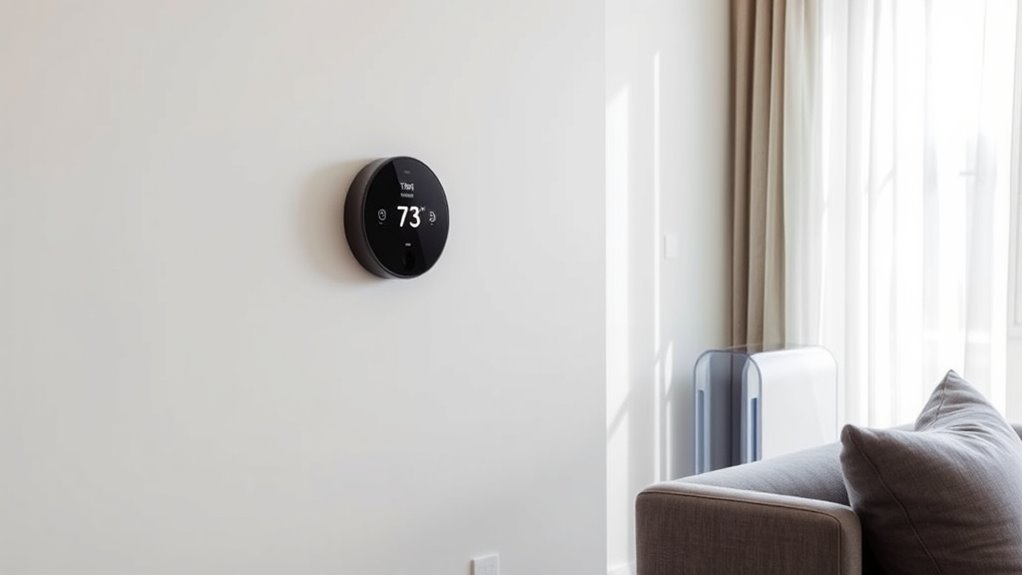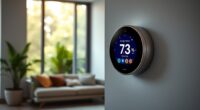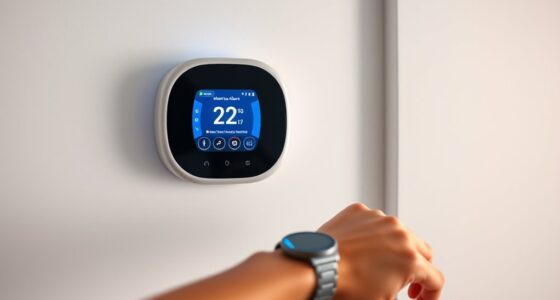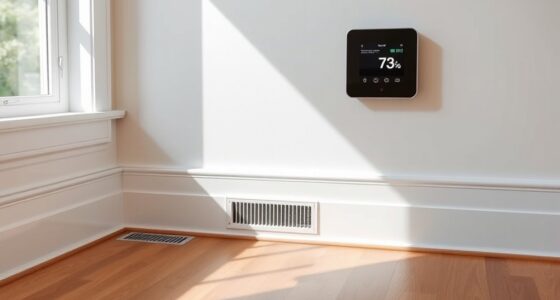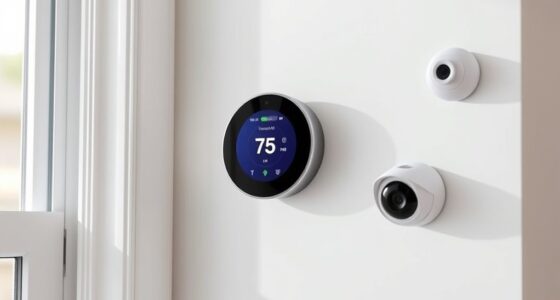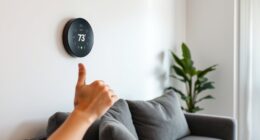Integrating your smart thermostat with a smart dehumidifier streamlines your home’s climate control, providing greater comfort and energy savings. When these devices work together, your thermostat can automatically adjust temperature based on humidity levels, while the dehumidifier responds to environmental changes without manual input. This seamless automation helps maintain consistent indoor conditions, reduces energy costs, and extends appliance life. Keep exploring to discover how this smart setup can transform your home’s environment.
Key Takeaways
- Smart thermostats can automatically adjust temperature settings based on humidity levels monitored by dehumidifiers.
- Integrating smart dehumidifiers with thermostats enhances overall home climate control and comfort.
- Automation systems enable real-time responses to humidity spikes, optimizing energy efficiency.
- Users can remotely control and schedule both devices via smartphone apps for personalized comfort.
- Proper integration promotes energy savings, device longevity, and a more sustainable home environment.

Integrating a smart thermostat with a dehumidifier can substantially enhance your home’s comfort and energy efficiency. When these devices work together seamlessly, you gain more precise control over your living environment, optimizing both humidity levels and temperature. This integration allows you to tailor your home’s climate to your preferences, all while minimizing energy waste. Instead of manually adjusting settings or relying on separate systems, you can automate your comfort, saving you time and money over the long run.
With a smart thermostat, you’re empowered with user control that’s far more intuitive than traditional models. You can set schedules, adjust temperature remotely via your smartphone, or even let the device learn your habits over time. When paired with a compatible dehumidifier, the system can automatically respond to changes in humidity levels, making real-time adjustments to maintain a consistent, comfortable environment. For example, if your home’s humidity rises unexpectedly, the dehumidifier can kick in without you needing to intervene, and the thermostat can adjust the temperature if the added moisture makes the air feel warmer or cooler. This dynamic interaction keeps your home at ideal comfort levels without unnecessary energy expenditure.
Moreover, integrating these devices promotes energy efficiency by reducing the workload on your HVAC system. When your dehumidifier manages excess moisture efficiently, your air conditioning or heating units don’t have to work as hard to maintain the desired temperature. This synergy helps cut down on energy bills and extends the lifespan of your appliances. You can also set your smart thermostat to prioritize energy savings during certain times of day, while the dehumidifier maintains optimal humidity levels, ensuring your home remains comfortable without wasting power.
User control becomes even more seamless with smart integrations, as you can customize settings to fit your lifestyle. You might program your system to lower the temperature slightly during the night while keeping humidity in check, or remotely adjust settings when you’re away from home. Many smart thermostats provide real-time alerts about humidity or temperature issues, giving you peace of mind and enabling quick responses. This level of control not only improves comfort but also enhances your home’s overall efficiency.
Additionally, understanding the importance of home environment control can help you make more informed decisions about integrating smart devices, ensuring you maximize their benefits. You might also consider maintenance and calibration to keep your system operating at peak performance, ensuring long-term reliability. In essence, connecting a smart thermostat with a dehumidifier offers a smarter, more responsive way to manage your indoor environment. By leveraging user control and focusing on energy efficiency, you create a more comfortable home that’s easier to maintain and more cost-effective in the long run. The synergy between these devices ensures that your living space remains perfectly conditioned, all while conserving energy and reducing your environmental footprint.
Frequently Asked Questions
Can Smart Thermostats Control Dehumidifiers From Any Brand?
You wonder if smart thermostats can control dehumidifiers from any brand. It depends on brand compatibility and device pairing options. Some smart thermostats support multiple brands through open protocols like Z-Wave or Zigbee, making control easier. Others may require specific integrations or smart home platforms, so check compatibility before purchasing. If the devices support common standards, you’re more likely to successfully pair and control your dehumidifier via your thermostat.
How Does Integration Affect Energy Savings in My Home?
Imagine your home as a finely-tuned orchestra, each instrument working in harmony. Integration of your smart thermostat and dehumidifier enhances this symphony, optimizing energy efficiency. You’ll notice cost savings as your system adjusts humidity and temperature precisely, reducing unnecessary energy use. This seamless control prevents overworking your HVAC, ensuring a comfortable environment while lowering utility bills. Fundamentally, integrated smart devices make your home smarter, greener, and more cost-effective.
Are There Security Concerns With Connected Smart Devices?
When you connect smart devices, you might worry about security concerns like privacy issues and unauthorized access. These devices can be vulnerable if not properly secured, so it’s essential to update firmware regularly, use strong passwords, and enable two-factor authentication. Taking these precautions helps protect your personal information and guarantees that unauthorized users can’t access your devices, keeping your smart home safe and secure.
What Is the Typical Setup Process for Integration?
Did you know over 60% of smart device users find integration challenging? To set up your smart thermostat with a smart dehumidifier, start by connecting both devices to your Wi-Fi network. Use the app to enable communication, then follow setup procedures involving humidity sensors calibration and device pairing. Confirm your devices are compatible, and update firmware if needed. This streamlined process helps optimize your home’s climate control effortlessly.
Can I Control Humidity Levels Remotely Through the Thermostat?
You can control humidity levels remotely through your smart thermostat if it has built-in humidity sensors and supports remote control features. Many smart thermostats allow you to adjust humidity settings via their app or interface from anywhere. This means you can monitor and optimize indoor moisture levels without being at home, giving you better comfort and energy efficiency. Just make certain your thermostat is compatible with your smart dehumidifier for seamless control.
Conclusion
By integrating your smart thermostat with a dehumidifier, you create a harmonious indoor climate—like a symphony where every instrument plays in perfect tune. This seamless connection not only enhances comfort but also boosts energy efficiency. Imagine your home as a well-orchestrated masterpiece, where temperature and humidity dance together effortlessly. Embrace this smart synergy, and watch your living space transform into a sanctuary of balance, comfort, and peace.
